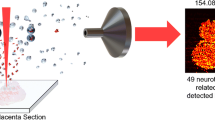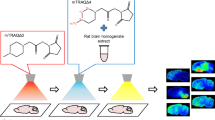Abstract
There is a pressing need to develop tools for assessing possible neurotoxicity, particularly for chemicals where the mode of action is poorly understood. Tetrabromobisphenol A (TBBPA), a highly abundant brominated flame retardant, has lately been targeted for neurotoxicity analysis by concerned public health entities in the EU and USA because it is a suspected thyroid disruptor and neurotoxicant. In this study, infrared matrix-assisted laser desorption electrospray ionization (IR-MALDESI) coupled to a Q Exactive Plus mass spectrometer was used for the analysis of neurotransmitters in the brains of rats exposed to TBBPA in gestation and lactation through their mothers. Three neurotransmitters of interest were studied in three selected regions of the brain: caudate putamen, substantia nigra (SN), and dorsal raphe. Stable isotope labeled (SIL) standards were used as internal standards and a means to achieve relative quantification. This study serves as a demonstration of a new application of IR-MALDESI, namely that neurotransmitter distributions can be confidently and rapidly imaged without derivatization.




Similar content being viewed by others
References
Galanopoulou AS. Sexually dimorphic expression of KCC2 and GABA function. Epilepsy Res. 2008. https://doi.org/10.1016/j.eplepsyres.2008.04.013.
How many chemicals are in use today? C&EN Global Enterp. 2017. https://doi.org/10.1021/cen-09509-govpol.
Heyer DB, Meredith RM. Environmental toxicology: sensitive periods of development and neurodevelopmental disorders. Neurotoxicology. 2017.
Malliari E, Kalantzi O. Children’s exposure to brominated flame retardants in indoor environments - a review. Environ Int. 2017;108:146–69.
Sugeng EJ, de Cock M, Schoonmade LJ, van de Bor M. Toddler exposure to flame retardant chemicals: magnitude, health concern and potential risk- or protective factors of exposure: observational studies summarized in a systematic review. Chemosphere. 2017;184:820–31.
Dingemans MML, van dB, Westerink RHS. Neurotoxicity of brominated flame retardants: (in)direct effects of parent and hydroxylated polybrominated diphenyl ethers on the (developing) nervous system. Environ Health Perspect. 2011. https://doi.org/10.1289/ehp.1003035.
Stapleton HM, Sharma S, Getzinger G, Ferguson PL, Gabriel M, Webster TF, et al. Novel and high volume use flame retardants in US couches reflective of the 2005 PentaBDE phase out. Environ Sci Technol. 2012. https://doi.org/10.1021/es303471d.
Knudsen GA, Hughes MF, McIntosh KL, Sanders JM, Birnbaum LS. Estimation of tetrabromobisphenol A (TBBPA) percutaneous uptake in humans using the parallelogram method. Toxicol Appl Pharmacol. 2015. https://doi.org/10.1016/j.taap.2015.09.012.
Antignac JP, Cariou R, Zalko D, Berrebi A, Cravedi JP, Maume D, et al. Exposure assessment of French women and their newborn to brominated flame retardants: determination of tri- to deca- polybromodiphenylethers (PBDE) in maternal adipose tissue, serum, breast milk and cord serum. Environ Pollut. 2009. https://doi.org/10.1016/j.envpol.2008.07.008.
Cariou R, Antignac JP, Zalko D, Berrebi A, Cravedi JP, Maume D, et al. Exposure assessment of French women and their newborns to tetrabromobisphenol-A: occurrence measurements in maternal adipose tissue, serum, breast milk and cord serum. Chemosphere. 2008. https://doi.org/10.1016/j.chemosphere.2008.07.084.
Lai DY, Kacew S, Dekant W. Tetrabromobisphenol A (TBBPA): possible modes of action of toxicity and carcinogenicity in rodents. Food Chem Toxicol. 2015. https://doi.org/10.1016/j.fct.2015.03.023.
National TP. NTP technical report on the toxicology studies of tetrabromobisphenol A (CASRN 79-94-7) in F344/NTac rats and B6C3F1/N mice and toxicology and carcinogenesis studies of tetrabromobisphenol A in Wistar Han Crl:WI(Han)] rats and B6C3F1/N mice (gavage studies). U.S. Department of Health and Human Services, Public Health Service, National Institutes of Health, National Toxicology Program. 2014.
Nakajima A, Saigusa D, Tetsu N, Yamakuni T, Tomioka Y, Hishinuma T. Neurobehavioral effects of tetrabromobisphenol A, a brominated flame retardant, in mice. Toxicol Lett. 2009. https://doi.org/10.1016/j.toxlet.2009.05.003.
Chughtai K, Heeren RMA. Mass spectrometric imaging for biomedical tissue analysis. Chem Rev. 2010. https://doi.org/10.1021/cr100012c.
Tanaka K, Waki H, Ido Y, Akita S, Yoshida Y, Yoshida T, et al. Protein and polymer analyses up to m/z 100 000 by laser ionization time-of-flight mass spectrometry. Rapid Commun Mass Spectrom. 1988. https://doi.org/10.1002/rcm.1290020802.
Karas M, Hillenkamp F. Laser desorption ionization of proteins with molecular masses exceeding 10,000 daltons. Anal Chem. 1988. https://doi.org/10.1021/ac00171a028.
Fenn JB, Mann M, Meng CK, Wong SF, Whitehouse CM. Electrospray ionization for mass spectrometry of large biomolecules. Science. 1989. https://doi.org/10.1126/science.2675315.
Norris JL, Caprioli RM. Analysis of tissue specimens by matrix-assisted laser desorption/ionization imaging mass spectrometry in biological and clinical research. Chem Rev. 2013. https://doi.org/10.1021/cr3004295.
Shariatgorji M, Nilsson A, Goodwin RJ, Kallback P, Schintu N, Zhang X, et al. Direct targeted quantitative molecular imaging of neurotransmitters in brain tissue sections. Neuron. 2014. https://doi.org/10.1016/j.neuron.2014.10.011.
Nemes P, Woods AS, Vertes A. Simultaneous imaging of small metabolites and lipids in rat brain tissues at atmospheric pressure by laser ablation electrospray ionization mass spectrometry. Anal Chem. 2010. https://doi.org/10.1021/ac902245p.
Bergman HM, Lundin E, Andersson M, Lanekoff I. Quantitative mass spectrometry imaging of small-molecule neurotransmitters in rat brain tissue sections using nanospray desorption electrospray ionization. Analyst. 2016. https://doi.org/10.1039/c5an02620b.
Fernandes AMAP, Vendramini PH, Galaverna R, Schwab NV, Alberici LC, Augusti R, et al. Direct visualization of neurotransmitters in rat brain slices by desorption electrospray ionization mass spectrometry imaging (DESI - MS). J Am Soc Mass Spectrom. 2016. https://doi.org/10.1007/s13361-016-1475-0.
Passarelli MK, Winograd N. Lipid imaging with time-of-flight secondary ion mass spectrometry (ToF-SIMS). Biochim Biophys Acta. 2011. https://doi.org/10.1016/j.bbalip.2011.05.007.
Bokhart MT, Muddiman DC. Infrared matrix-assisted laser desorption electrospray ionization mass spectrometry imaging analysis of biospecimens. Analyst. 2016. https://doi.org/10.1039/c6an01189f.
Robichaud G, Barry J, Muddiman D. IR-MALDESI mass spectrometry imaging of biological tissue sections using ice as a matrix. J Am Soc Mass Spectrom. 2014. https://doi.org/10.1007/s13361-013-0787-6.
Esteve C, Tolner EA, Shyti R, van dM, McDonnell LA. Mass spectrometry imaging of amino neurotransmitters: a comparison of derivatization methods and application in mouse brain tissue. Metabolomics. 2016. https://doi.org/10.1007/s11306-015-0926-0.
Sakino T, Yuki S, Akiko K, Mitsuyo O, Sachise K, Toshimi M, et al. Microscopic imaging mass spectrometry assisted by on-tissue chemical derivatization for visualizing multiple amino acids in human colon cancer xenografts. Proteomics. 2014. https://doi.org/10.1002/pmic.201300041.
Shariatgorji M, Nilsson A, Goodwin RA, Källback P, Schintu N, Zhang X, et al. Direct targeted quantitative molecular imaging of neurotransmitters in brain tissue sections. Neuron. 2014;84:697–707.
Bokhart MT, Rosen E, Thompson C, Sykes C, Kashuba ADM, Muddiman DC. Quantitative mass spectrometry imaging of emtricitabine in cervical tissue model using infrared matrix-assisted laser desorption electrospray ionization. Anal Bioanal Chem. 2015. https://doi.org/10.1007/s00216-014-8220-y.
Paxinos G, Watson C. The rat brain in stereotaxic coordinates. London: Academic Press; 2007.
Arambula SE, Fuchs J, Cao J, Patisaul HB. Effects of perinatal bisphenol A exposure on the volume of sexually-dimorphic nuclei of juvenile rats: a CLARITY-BPA consortium study. NeuroToxicology. 2017;63:33–42.
Cao J, Joyner L, Mickens JA, Leyrer SM, Patisaul HB. Sex-specific Esr2 mRNA expression in the rat hypothalamus and amygdala is altered by neonatal bisphenol A exposure. Reproduction. 2014. https://doi.org/10.1530/rep-13-0501.
Ekelöf M, Manni J, Nazari M, Bokhart M, Muddiman DC. Characterization of a novel miniaturized burst-mode infrared laser system for IR-MALDESI mass spectrometry imaging. Anal Bioanal Chem. 2018. https://doi.org/10.1007/s00216-018-0918-9.
Robichaud G, Garrard KP, Barry JA, Muddiman DC. MSiReader: an open-source interface to view and analyze high resolving power MS imaging files on Matlab platform. J Am Soc Mass Spectrom. 2013. https://doi.org/10.1007/s13361-013-0607-z.
Bokhart MT, Nazari M, Garrard KP, Muddiman DC. MSiReader v1.0: evolving open-source mass spectrometry imaging software for targeted and untargeted analyses. J Am Soc Mass Spectrom. 2017. https://doi.org/10.1007/s13361-017-1809-6.
Chambers MC, Maclean B, Burke R, Amodei D, Ruderman DL, Neumann S, et al. A cross-platform toolkit for mass spectrometry and proteomics. Nat Biotechnol. 2012. https://doi.org/10.1038/nbt.2377.
Race AM, Styles IB, Bunch J. Inclusive sharing of mass spectrometry imaging data requires a converter for all. J Proteomics. 2012. https://doi.org/10.1016/j.jprot.2012.05.035.
Hines M, Allen LS, Gorski RA. Sex differences in subregions of the medial nucleus of the amygdala and the bed nucleus of the stria terminalis of the rat. Brain Res. 1992;579:321–6.
Frazer A, Hensler JG. Anonymous basic neurochemistry molecular, cellular and medical aspects. 6th ed. Philadelphia: Lippincott-Raven; 1999.
Yu X, Ye Z, Houston C, Zecharia A, Ma Y, Zhang Z, et al. Wakefulness is governed by GABA and histamine cotransmission. Neuron. 2015. https://doi.org/10.1016/j.neuron.2015.06.003.
Ponvert C, Galoppin L, Scheinmann P, Canu P, Burtin C. Tissue histamine levels in male and female mast cell deficient mice (W/Wv) and in their littermates (Wv/+, W/+ and +/+). Agents Actions. 1985. https://doi.org/10.1007/BF01966671.
Netter KJ, Cohn VH, Shore PA. Sex difference in histamine metabolism in the rat. Am J Physiol. 1961. https://doi.org/10.1152/ajplegacy.1961.201.2.224.
Acknowledgements
All mass spectrometry measurements were made in the Molecular Education, Technology, and Research Innovation Center (METRIC) at NC State University. We are grateful for the NIEHS research team who designed and executed the TBBPA exposure portion of this project, especially Suzanne Fenton, Manushree Bharadwaj, Joshua Warmack, and Sagi Enicole Gillera.
Funding
This study received financial assistance from the National Institutes of Health grants R01GM087964 (MCB, ME, DM) and P30ES025128 to North Carolina State University as well as a National Institutes of Health IPA Agreement with HP.
Author information
Authors and Affiliations
Corresponding author
Ethics declarations
All aspects of the rat studies were approved by the Institutional Animal Care and Use Committees of NIEHS and NCSU.
Conflict of interest
The authors declare that they have no conflicts of interest
Electronic supplementary material
ESM 1
(PDF 3448 kb)
Rights and permissions
About this article
Cite this article
Bagley, M.C., Ekelöf, M., Rock, K. et al. IR-MALDESI mass spectrometry imaging of underivatized neurotransmitters in brain tissue of rats exposed to tetrabromobisphenol A. Anal Bioanal Chem 410, 7979–7986 (2018). https://doi.org/10.1007/s00216-018-1420-0
Received:
Revised:
Accepted:
Published:
Issue Date:
DOI: https://doi.org/10.1007/s00216-018-1420-0




